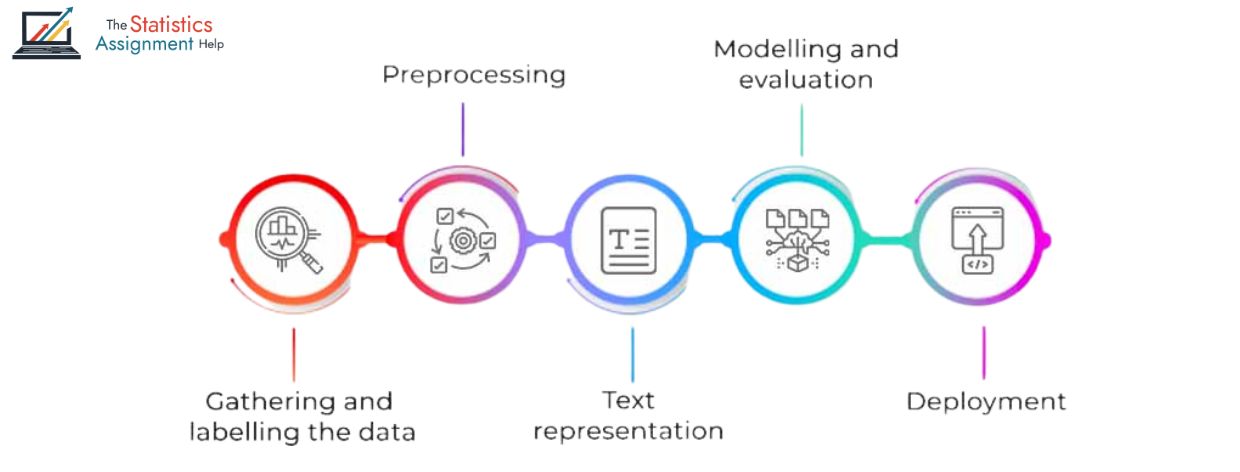
- 1st Mar 2024
- 06:03 am
In the present-day digital landscape where millions of words are produced every moment, it is increasingly important to be able to gauge the emotions behind that text. Sentiment analysis i.e. aspect of natural language processing (NLP) can be used to find out whether a text conveys a positive, negative or neutral sentiment. Our team of professionals can assist you in completing your sentiment analysis assignment in case you are having trouble with the task. Our instructions and assistance are extensive so that you can learn some of the major concepts and succeed with your homework. This blog will be discussing the functioning of sentiment analysis, principal methods and applications in text based sentiment interpretation.
Understanding Sentiment Analysis
Sentiment analysis; also known as opinion mining is an emotion detective in a text. It filters through the words to establish whether the author is good, bad, or impassive. Companies use it to understand what their consumers think of them, how their companies are viewed and take decisions that are informed in matters relate to how people feel about them.
Methods and Techniques:
1. Lexicon-based Approaches:
- Utilize sentiment lexicons or dictionaries with preset sentiment scores for words.
- Assign sentiment scores to text based on the appearance of positive or negative words.
- Easy to understand but may not capture context effectively.
2. Machine Learning Models:
- Supervised learning algorithm lays the text in its desired classes of sentiments (negative, positive, neutral), based on labeled training data.
- The popular classifiers, such as Support Vector Machines (SVM), Naive Bayes, and Logistic Regression are used.
- Training requires annotated datasets, yielding better accuracy with ample data.
3. Deep Learning Models:
- Recurrent Neural Networks (RNNs), Long Short-term Memory (LSTM) networks and Convolutional Neural Networks (CNNs) are well-equipped to extract sequential patterns and semantic meanings.
- Transformer models, including BERT, apply contextual understanding based on an attention process.
- While these models achieve top-tier performance, they demand extensive labeled data and computational power.
Data Preprocessing
A set of preprocessing operations on the text data is performed before moving on to sentiment analysis to ensure that the model performs optimally and noise is sufficiently reduced. Such steps are:
- Tokenization: Decomposition of the text to single words or tokens.
- Lowercasing: Changing lowercase text into lower case, to be consistent.
- Removing stop words: Removal of such common words as and the etc, with little meaning attached with them.
- Stemming/lemmatization: Converting words to their base form in order to standardize variation in words to enhance accuracy in sentiment classification.
Feature Extraction
However cleaning and preparation of the text are required before running sentiment analysis. This means breaking the text to word and converting the text to small case and take down the word that does not necessary to the data for example like “and” or “the” and reducing the word to base for example through stemming, lemmatization etc. These actions assist models more effectively sense and analyze text so it could analyze sentiment properly.
Model Training and Evaluation:
1. Train-test Split:
- The dataset is divided into training and testing sets.
- Typically, 70-80% of the data is used for training.
- The remaining portion is allocated for testing the model's performance.
- This separation ensures evaluation on unseen data for reliable results.
2. Performance Metrics:
In evaluating sentiment analysis models, we often rely on several key metrics:
- Accuracy: This parameter shows the frequency of correct responses of the model in general.
- Precision: It indicates the percentage of accuracy of correct prediction of positive sentiments including all the predictions of positive sentiments.
- Recall: This measure shows the percentage of accurately identified positive sentiments out of all grammatically positive sentiments that exist.
- F1-score: F1-score gives a balanced measure of precision and recall, and it gives an all-round look at how effective the model is performing.
- Confusion matrix: A frequency table that illustrates the accuracy of the model with respect to sentiment classification, and which provides information regarding the strengths and weaknesses of the model.
3. Cross-Validation:
- K-fold cross-validation is used to make the model more robust, which trains the model k times with k partitions of data. Each time a new set is used in training and the rest of the subsets in validation and a comprehensive coverage over the entire corpus is made.
Model Deployment
Sentiment analysis models are deployed after training and assessment to fulfill different purposes, such as social media monitoring applications, customer feedback analysis applications, and chatbots. The sentiment analysis is only automatable in real time and the accuracy and efficiency in extracting the sentiments of the users across various platforms are improved using these models.
Challenges and Considerations
1. Domain-specific Sentiments:
- Sentiment analysis models trained on generic datasets may struggle with domain-specific language and sentiments.
- Domain adaptation techniques, transfer learning, and fine-tuning models on domain-specific data can address this challenge.
2. Ambiguity and Sarcasm:
- Ambiguous or sarcastic text can confuse sentiment analysis models, leading to misclassifications.
- Context-aware modeling and sarcasm detection techniques help mitigate this issue.
3. Data Imbalance:
- Imbalanced classes with one of the sentiments predominating in the sample could interfere with predictions.
- Ensuring that the classes are balanced encounters the techniques such as oversampling, undersampling, and SMOTE (Synthetic Minority Over-sampling Technique).
Applications of Sentiment Analysis
- Customer Feedback Analysis: Businesses scrutinize customer reviews and social media comments to grasp consumer sentiments regarding products and services.
- Brand Monitoring: Enterprises keep tabs on brand mentions online to assess brand sentiment and reputation.
- Financial Market Analysis: Sentiment analysis of news articles and social media posts aids investors in forecasting market trends and sentiment-driven price fluctuations.
- Political Opinion Mining: Governments and political analysts study public sentiments towards political candidates and policies to gauge voter sentiment.
Conclusion
Sentiment analysis is a method of understanding text data, and its use enables businesses to read the opinion of the masses and make decisions accordingly. It derives useful information on large data sets using important techniques that can lead to innovations and strategy in any industry. The role of the field in the decision-making process will also rise in the future as it characterizes data-driven decisions and sentiment-aware technologies. To the learners who need Machine Learning Assignment Help, the sentiment analysis would be necessary to apply the ideas of NLP in practical conditions.
About The Author
- Name: Smithii Rayan
- Qualification: Master's Degree in Computer Science
- Research Focus: Natural Language Processing and Sentiment Analysis
- Expertise: Has experience in sentiment analysis modeling, with machine and deep learning. Experience in preprocessing of the texts, extraction of the features, and evaluation of the model in sentiment classification.








